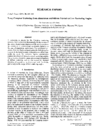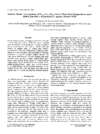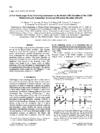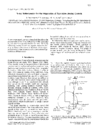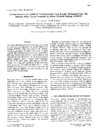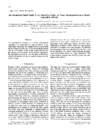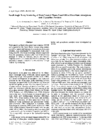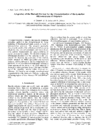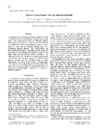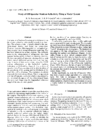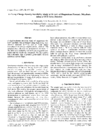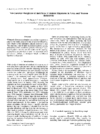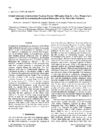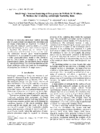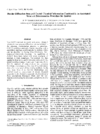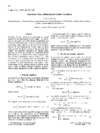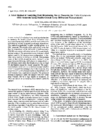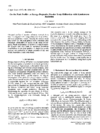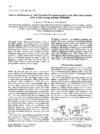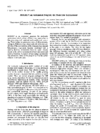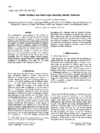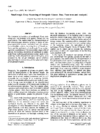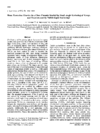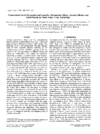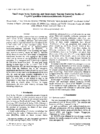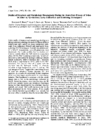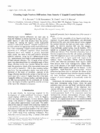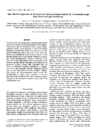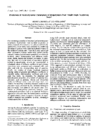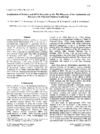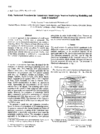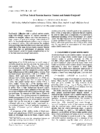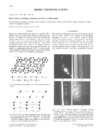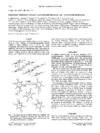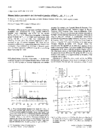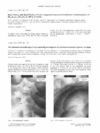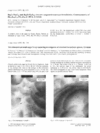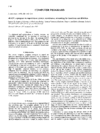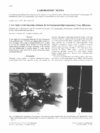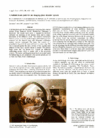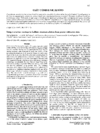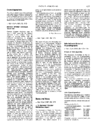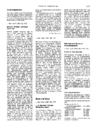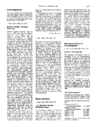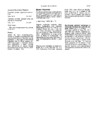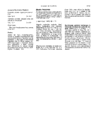issue contents
December 1997 issue

Cover illustration: A crystal of the protein phosphorylase b flash-cooled to 100 K in a 1 mm-diameter mohair loop prior to collection of X-ray diffraction data. Courtesy of Elspeth Garman and Stephen Lee, University of Oxford.
research papers
A correction is shown for the Compton scattering intensity that is calculated theoretically for free atoms, if the loosely bound outer electrons of the atoms construct the conduction or valence band in crystals, typically in the case of aluminium and silicon.
Atomic displacement parameters were derived from a temperature-factor analysis of Bragg reflections. An interpretation is given towards the migration of the oxygen ions under the action of an applied direct-current electric field.
The design and performance of the new SAXS modular instrument having easily variable wavelength are described. Tests reveal a previously unrecognized phenomenon, namely diffuse scattering from the mirrors; this can be reduced by rearrangement of the positions of the slits.
A novel angular-dispersive X-ray reflectometer that allows the measurement of the X-ray reflectivity of thin layers, contained in a chamber, is described. The X-rays are focused by a Johansson monochromator using the Si(333) Bragg diffraction.
The crystal structure of a layered compound containing 24 independent atoms was solved ab initio from X-ray laboratory powder data. The procedures applied are described. By powder diffraction study, the appropriate chemical formula was found.
Anomalous small-angle X-ray scattering measurements on the precipitation structure in an NiCrAl alloy have been performed. Ni partition was found to be the same in the matrix and the precipitates.
The effects of heat treatment on the structure of flame-fused silica glass from amorphous and crystalline powders were investigated by small-angle X-ray scattering.
A variant of the Rietveld refinement procedure applied to the characterization by WAXS of disordered and small crystals as found in semi-crystalline polymers is described.
The radiation transmission characteristics of a tapered cylinder may be described using analytical expressions developed for the straight cylinder, but with a lower effective critical angle that depends on the taper length and angle.
Off-specular neutron reflection from an optical grating has detected in-plane periodicity up to 42 μm. This is much longer than expected from the coherence length of the neutron beam but is consistent with the instrumental resolution.
Scattering of colloids is identified by variation of the X-ray energy near the absorption edge of gold. Results from small-angle X-ray scattering after correction for absorption and refraction are compared with high-resolution transmission electron micro- scopy and optical UV visible spectroscopy.
A high-resolution structural study of magnesium formate dihydrate was performed using high-energy synchrotron radiation and an X-ray image intensifier/CCD detector.
A cumulant expansion was performed to calculate X-ray or neutron reflectivity.
A new development of the Monte Carlo technique for structure solution from powder diffraction data, involving restrained relaxation of the geometry of the structural fragment during the Monte Carlo calculation, is reported.
A method for obtaining anisotropic correlation functions is presented and modelling of the scattering data by a modified para- crystal model is described.
The FOCUS method, in which both crystal chemical information and powder diffraction data are included in the structure determination process, is presented. FOCUS combines automatic Fourier recycling with a specialized topology search specific to zeolites.
This paper describes an algorithm for peak search in the three-dimensional Fourier map that is more convenient and faster than conventional two-dimensional Fourier synthesis.
A novel method of analyzing X-ray peak broadening due to mosaicity for double-crystal X-ray diffraction measurements is proposed.
The peak profiles of standard reference materials have been investigated with energy-dispersive X-ray diffraction at a synchro- tron source. A single-line profile analysis was performed to obtain estimates of size and strain in plastically deformed f.c.c.-based metals.
Results from in situ grazing incidence diffraction and X-ray reflectivity measurements at different temperatures are presented. The structure, texture and epitaxic growth of thin Pt, Pt2Si and PtSi layers on Si(111) and (001) surfaces are analyzed.
An automated program for molecular replacement using a full-symmetry translation function combined with a packing function is described.
The oscillatory deviations arising from parallel interfaces, when the latter are diffuse, are still observable in the Porod plot provided that the ratio of the diffuse region thickness to the parallel interface distance is less than 1/4.
A fast and reliable algorithm has been developed for auto- indexing oscillation images. The program has successfully determined the lengths and directions of basis vectors for numerous unit cells having cell dimensions ranging from 16 to 688 Å and oscillation ranges from 0.2 to 2.0°.
Properties of the decomposition kinetics in Cu–Co alloys were determined by time-resolved ASAXS measurements.
The treatment and analysis of SAXS data are reviewed with specific concern for glass science. The methods developed are illustrated by SAXS and ASAXS scattering results obtained from optical filter glass, glass produced by the sol–gel technique, optical colourless glass inclining to opalescence, porous glass and single-phase phosphate glass.
The primary phase formation in an MgO–Al2O3–SiO2 base glass for glass ceramics was investigated by combining different small-angle scattering techniques. The effect of TiO2 and ZrO2 as nucleating agents on the first stage of crystallization was clarified using contrast variation.
Small-angle X-ray scattering was used to characterize various mesoporous silicas, aluminosilicates and gallosilicates.
Liquid-crystalline halato(semi)telechelic polymers have been studied using small-angle X-ray scattering and small-angle neutron scattering
The development of structure and morphology during the heat-draw process of a nylon 66 fiber was investigated by two- dimensional WAXD and SAXS methods using synchrotron radiation. The results indicate that a premelting process precedes the Brill transition during the chosen processes.
Glancing-angle neutron diffraction has been used to study the variation in smectic layer tilt in high- and low-pretilt smectic C cells with distance from the surface.
Time-resolved small-angle light scattering was used to study phase separation phenomena of the water–octane–tetraethylene glycol monodecyl ether microemulsion system.
Structural parameters of biopolymers derived from small-angle scattering were used to calculate and estimate hydrodynamic parameters. The validity of several approaches was tested with different types of molecules.
Questions of biological structure research that cannot be solved because of insufficient contrast conditions could be answered by spin contrast variation.
A numerical approach to the evaluation of two-dimensional small-angle neutron scattering data which includes interparticle-interference and multiple-scattering effects is described.
The present and future prospects of small-angle neutron scattering at pulsed neutron sources are reviewed.
short communications
The antiphase domains can be explained in terms of the ordering of the Cl ion in the channels of the chlorapatite structure. The displacement vector of the domain was found to be 1/2 [010].
Experimental observations of the fine structure of a bent-crystal rocking curve, made with a double-crystal diffractometer, are reported.
X-ray powder diffraction on mixed crystalline samples has been performed to determine which of the two forms of l,2,4,5-tetra- bromobenzene (TeBB) is isomorphous with the room temperature form of l,2,4,5-tetrachlorobenzene (TeCB). It is found that β TeCB is isomorphous in the strictest sense (i.e. capable of giving a continuous series of mixed crystals) with the γ form of TeBB.
An X-ray powder diffraction study of the structural characteristics and thermal expansion between room temperature and 873 K is reported for the system HoNi5−xAlx, 4 ≥ x ≥ 0.
computer programs
The program ALIGN determines the transformation to superimpose structurally homologous protein domains. The results are expressed in terms of the rotation and translation necessary to effect the transformation.
laboratory notes
A new single-crystal mounting technique for high-temperature X-ray diffraction up to 1700 K is briefly described. The major advantage of the method is the very low background, because the sample is clamped by thin microcrystalline fibres without using any glue or cement.
A helium beam path for the marresearch imaging-plate detector system is described.
fast communications
A periodic nodal surface that partitions a unit cell into regions of high and low electron density can be calculated from a few strong, low-index reflections. This `structure envelope' can then be used to facilitate structure solution from powder diffraction data.
crystallographers
Free 

notes and news
Free 

international union of crystallography
Free 

books received
Free 

Free 

Free 



 journal menu
journal menu









